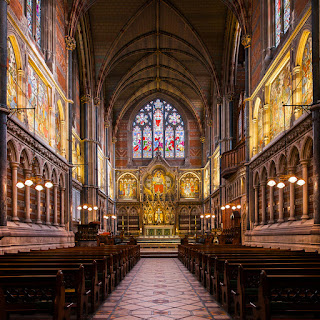Don't fear flaws and fallibility, by Ben Jeapes
 |
| https://www.keble.ox.ac.uk/about/chapel/ |
All the land to the north was owned by St John’s College, which was renowned as the most worldly and thickest college in the university. (Apologies to any St John’s alumni reading this: I should say that the speaker himself was one of your number.) Its founder, Sir Thomas White, also founded the Merchant Taylors School, which had the right to send scholars to St John’s without St John’s having a say. Therefore it sent the dregs of its scholars who couldn’t get in anywhere else. They inevitably became Fellows and many took holy orders. Dean Stanley of Westminster once visited and tried to interest the high table in his recent trip to the Holy Land. He was told, ‘hang Jerusalem, give us wine, women and horses.’
It was these people who drove the development of north Oxford. The Fellows wanted to maximise their profit so it was socially engineered towards Anglican, upper class high income families. The leases of the new houses stipulated the two things no home could be used as: a pub, or a ‘dissenting conventicle’. It was only safe to be a dissenter once you were north of Marston Ferry Road.
But, they also encouraged the growth of academic institutions, which included two theological colleges, St Stephen’s House (originally in north Oxford) and Wycliffe Hall; Lady Margaret Hall, one of the university’s first colleges for women; and Keble, where the riotous beauty of the chapel fairly screams out the glory of God. (It’s also where you can go to see the original of Hunt’s ‘Light of the World’.) Out of all that dissolute greed came a lot of good.
It became the thing in this wealthy, aspirational neighbourhood for rich families to buy their own comfortable box pew in church. The demand for private box pews outstripped the space available in the medieval St Giles, so St Philip & St James church was built to take the overflow, shortly followed by St Margaret’s. Building churches was a bit like Waitrose coming to town: it was a seal of approval on the neighbourhood. But, they were built, and once built, the word was preached in them.
What struck me in all of this was how God was working, even through (and despite) the extremely worldly and venal motivations of the Fellows of St John’s. The net effect of all this: God’s kingdom advanced.
As Paul says in Philippians: whatever the motives, what matters is that Christ is preached. That is the real world but the worlds of our fiction can fail to reflect this: everything is too black and white. All the theological sense comes from the ‘good’ character. The ‘bad’ character has no clue until they see the light. Even if we allow ourselves the luxury of a flawed, sinful character, once they’ve had the obligatory conversion then everything is right from then on. Whereas they, like us, will probably be kicking over the traces until the day they die.
Last week my wife met, in the course of her work, an American prosperity gospel preacher, here to do a lecture tour of the UK. Bad! But the subject he is here to lecture on? Making your church autism-friendly. Good!
Why not put a character in your next book who talks 95% nonsense and 5% sound teaching? And make it the 5% that matters.
God chooses to act through fallible people. So, when we write, let’s give him some.
Ben Jeapes took up writing in the mistaken belief that it would be easier than a real job (it isn’t). Hence, as well as being the author of 5 novels and co-author of many more, he has also been a journal editor, book publisher, and technical writer. www.benjeapes.com

Amen!
ReplyDeleteBen, I love, love, LOVE this!!! I am in bed with 'flu feeling blooming awful, but as a 19th century geek, your post is balm to my raw throat and achy limbs. It's packed full of great descriptive language, social history and wisdom. Exactly! "good" and "bad" are just not that black and white. Thank you for making a tired, miserable old gal smile on this bright March morning.
ReplyDeleteSo glad I could help, and I hope you feel better soon!
ReplyDeleteGreat post, Ben. I love your idea of putting someone like that in our book. because that is so what real people are like. so what we are like.
ReplyDeleteHey, this was by William Whyte, wasn't it? He is a really great and entertaining preacher (sometimes at the church we go to) and I guess a good lecturer as well. Also, that St John's college continues its tradition... as for North Oxford - house prices are silly and most Uni staff are forced into Marston, East Oxford, Kidlington, or the villages beyond...
ReplyDeleteWilliam Whyte the lecturer? Very good, and entertaining. Sometimes preaches at our church. You are so right about the conventions of 'Christian novels'. Mine dare to be different though... possibly a bit too complex and wordly for the Christian label, but not intended to be. North Oxford is well described - and St John's has maintained its tradition... Thanks for a great blogpost.
ReplyDeleteGreat post. And when you think about it, the Bible is chock-a-block with the fallible and those who mess up, time and time and time again, yet many of them get fabulous mentions later on! SO reassuring!
ReplyDelete